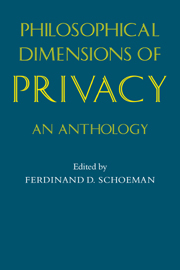Book contents
- Frontmatter
- Contents
- List of contributors
- Preface
- 1 Privacy: philosophical dimensions of the literature
- 2 Social distance and the veil
- 3 The origins of modern claims to privacy
- 4 The right to privacy [the implicit made explicit]
- 5 Privacy [a legal analysis]
- 6 Privacy as an aspect of human dignity: an answer to Dean Prosser
- 7 Privacy [a moral analysis]
- 8 Privacy, freedom, and respect for persons
- 9 Privacy and self-incrimination
- 10 Intimacy and privacy
- 11 The right to privacy
- 12 Why privacy is important
- 13 Privacy, intimacy, and personhood
- 14 Privacy: some arguments and assumptions
- 15 An economic theory of privacy
- 16 Privacy and the limits of law
- 17 Privacy and intimate information
- Selected bibliography
- Index of names
2 - Social distance and the veil
Published online by Cambridge University Press: 12 December 2009
- Frontmatter
- Contents
- List of contributors
- Preface
- 1 Privacy: philosophical dimensions of the literature
- 2 Social distance and the veil
- 3 The origins of modern claims to privacy
- 4 The right to privacy [the implicit made explicit]
- 5 Privacy [a legal analysis]
- 6 Privacy as an aspect of human dignity: an answer to Dean Prosser
- 7 Privacy [a moral analysis]
- 8 Privacy, freedom, and respect for persons
- 9 Privacy and self-incrimination
- 10 Intimacy and privacy
- 11 The right to privacy
- 12 Why privacy is important
- 13 Privacy, intimacy, and personhood
- 14 Privacy: some arguments and assumptions
- 15 An economic theory of privacy
- 16 Privacy and the limits of law
- 17 Privacy and intimate information
- Selected bibliography
- Index of names
Summary
The company scatters, the lights go out, the song dies, the guitars grow silent, as they approach the habitations of man. Put on your masks; you are again among your brothers.
José Rizal in Noli Me TangereThis is an essay on the means by which man promotes the establishment of social relationships and the maintenance of social interaction through aloofness, removal, and reserve. It attempts, on one level, to present a functional interpretation of a curious Tuareg custom, but, in a more general sense, the paper undertakes an exposition of certain dialectical processes in social life.
The question I have asked of a body of field data is very simply: why do Tuareg males cover their faces so completely that only areas around the eyes and nose may be seen? We will come back to this matter in greater detail, but, for introductory purposes, my answer is that by doing so, they are symbolically introducing a form of distance between their selves and their social others. The veil, though providing neither isolation nor anonymity, bestows facelessness and the idiom of privacy upon its wearer and allows him to stand somewhat aloof from the perils of social interaction while remaining a part of it.
Social distance
It is not my purpose to become involved in a general exegesis on the subject of social distance, privacy and reserve, and I wish in these prefatory comments only to inform the reader of the theoretical framework within which I am operating.
- Type
- Chapter
- Information
- Philosophical Dimensions of PrivacyAn Anthology, pp. 34 - 55Publisher: Cambridge University PressPrint publication year: 1984
- 7
- Cited by



